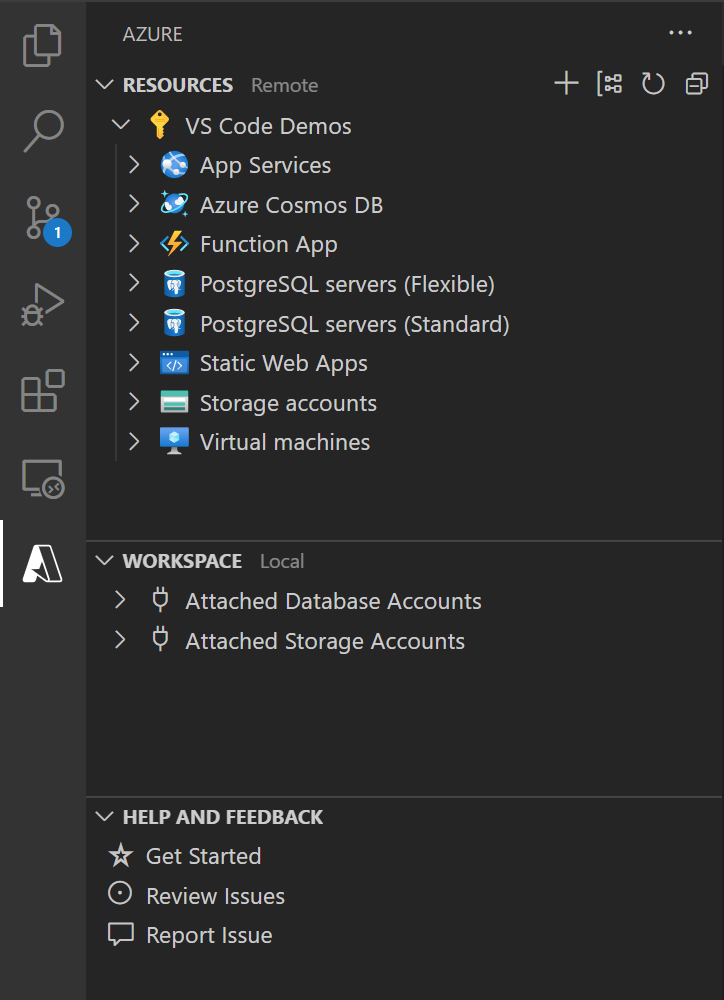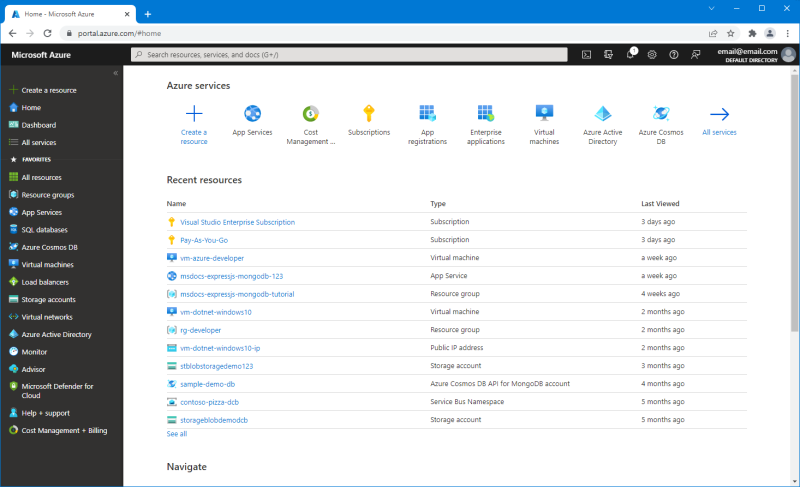How do I create and manage resources in Azure?
Azure provides a variety of tools to create and manage the Azure resources used by your application.
Different tools are designed to support different use cases, and most Azure developers use a combination of different tools depending on the job they need to perform. For example, you might:
Use a GUI tool like the Azure portal or the Azure Tools extension for VS Code when prototyping Azure resources for a new application. GUI tools guide you through the process of creating new services and let you review and select the options for a service using drop-down menus and other graphical elements.
Write a script using the Azure CLI or Azure PowerShell to automate a common task. For example, you might create a script that creates a basic dev environment for a new web application consisting of an Azure App Service, a database, and blob storage. Writing a script ensures the resources are created the same way each time and is faster to run than clicking through a UI.
Use Infrastructure as Code (IaC) tools to declaratively deploy and manage Azure resources. Tools like Terraform, Ansible, or Bicep allow you to codify the Azure resources needed for a solution in declarative syntax, ensuring the consistent deployment of Azure resources across environments and preventing environmental drift.
Azure portal
The Azure portal is a web-based interface designed for managing Azure resources. The Azure portal features:
- An easy to use, web-based UI for creating and managing Azure resources
- The ability to create configurable dashboards
- Access to subscription settings and billing information
VS Code Azure Tools Extension Pack
Developers using Visual Studio Code can manage Azure resources right from VS Code using the Azure Tools Extension Pack for VS Code. Using the Azure Tools Extension Pack can:
- Create, manage, and deploy code to web sites using Azure App Service.
- Create, browse, and query Azure databases
- Create, debug, and deploy Azure Functions directly from VS Code
- Deploy containerized applications from VS Code

Command line tools
Command line tools offer the benefits of efficiency, repeatability, and the ability to script recurring tasks. Azure provides two different command line tools to choose from. The Azure CLI and Azure PowerShell are functionally equivalent. You only need to select and use the tool that best fits your individual workflow.
Azure CLI
The Azure CLI is a cross-platform command line tool that runs on Windows, Linux and macOS. The Azure CLI:
- Features a concise, efficient syntax for managing Azure resource.
- Outputs results as JSON (by default). Results can also be formatted as YAML, an ASCII table or tab-separated values with no keys.
- Provides the ability to query and shape output through the use of JMESPath queries.
Azure CLI commands are easily incorporated into popular scripting languages like Bash giving you the ability to script common tasks.
LOCATION='eastus'
RESOURCE_GROUP_NAME='msdocs-expressjs-mongodb-tutorial'
WEB_APP_NAME='msdocs-expressjs-mongodb-123'
APP_SERVICE_PLAN_NAME='msdocs-expressjs-mongodb-plan-123'
RUNTIME='NODE|14-lts'
# Create a resource group
az group create \
--location $LOCATION \
--name $RESOURCE_GROUP_NAME
# Create an app service plan
az appservice plan create \
--name $APP_SERVICE_PLAN_NAME \
--resource-group $RESOURCE_GROUP_NAME \
--sku B1 \
--is-linux
# Create the web app in the app service
az webapp create \
--name $WEB_APP_NAME \
--runtime $RUNTIME \
--plan $APP_SERVICE_PLAN_NAME \
--resource-group $RESOURCE_GROUP_NAME
Azure PowerShell
Azure PowerShell is a set of cmdlets for managing Azure resources directly from PowerShell. Azure PowerShell is installed as a PowerShell module and works with PowerShell 7.0.6 LTS and PowerShell 7.1.3 or higher on all platforms including Windows, macOS, and Linux. It's also compatible with Windows PowerShell 5.1.
Azure PowerShell is tightly integrated with the PowerShell language. Commands follow a verb-noun format and data is returned as PowerShell objects. If you are already familiar with PowerShell scripting, Azure PowerShell is a natural choice.
$location = 'eastus'
$resourceGroupName = 'msdocs-blob-storage-demo-azps'
$storageAccountName = 'stblobstoragedemo999'
# Create a resource group
New-AzResourceGroup `
-Location $location `
-Name $resourceGroupName
# Create the storage account
New-AzStorageAccount `
-Name $storageAccountName `
-ResourceGroupName $resourceGroupName `
-Location $location `
-SkuName Standard_LRS
For more information on choosing between Azure CLI and Azure PowerShell, see the article Choose the right command-line tool.
Infrastructure as Code tools
Infrastructure as Code is the process of managing and provisioning resources through declarative configuration files. Infrastructure as code tools use a declarative end state specification to guarantee a set of resources are created and configured the same way each time. Further, most infrastructure as code tools monitor resources to make sure they remain configured in the desired state.
For infrastructure deployments that are automated, repeated, and reliable, Azure supports a variety of Infrastructure as Code tools.
Bicep
Bicep is a domain-specific language (DSL) that uses declarative syntax to deploy Azure resources. It provides concise syntax, reliable type safety, and support for code reuse.
param location string = resourceGroup().location
param storageAccountName string = 'toylaunch${uniqueString(resourceGroup().id)}'
resource storageAccount 'Microsoft.Storage/storageAccounts@2021-06-01' = {
name: storageAccountName
location: location
sku: {
name: 'Standard_LRS'
}
kind: 'StorageV2'
properties: {
accessTier: 'Hot'
}
}
Terraform
Hashicorp Terraform is an open-source tool for provisioning and managing cloud infrastructure. It codifies infrastructure in configuration files that describe the topology of cloud resources. The Terraform CLI provides a simple mechanism to deploy and version configuration files to Azure.
provider "azurerm" {
features {}
}
resource "azurerm_resource_group" "main" {
name = "${var.prefix}-resources"
location = var.location
}
resource "azurerm_app_service_plan" "main" {
name = "${var.prefix}-asp"
location = azurerm_resource_group.main.location
resource_group_name = azurerm_resource_group.main.name
kind = "Linux"
reserved = true
sku {
tier = "Standard"
size = "S1"
}
}
resource "azurerm_app_service" "main" {
name = "${var.prefix}-appservice"
location = azurerm_resource_group.main.location
resource_group_name = azurerm_resource_group.main.name
app_service_plan_id = azurerm_app_service_plan.main.id
site_config {
linux_fx_version = "NODE|10.14"
}
}
Ansible
Ansible is an open-source product that automates cloud provisioning, configuration management, and application deployments. Using Ansible you can provision virtual machines, containers, and network and complete cloud infrastructures. Also, Ansible allows you to automate the deployment and configuration of resources in your environment.
- hosts: localhost
connection: local
vars:
resource_group: myResourceGroup
webapp_name: myfirstWebApp
plan_name: myAppServicePlan
location: eastus
tasks:
- name: Create a resource group
azure_rm_resourcegroup:
name: "{{ resource_group }}"
location: "{{ location }}"
- name: Create App Service on Linux with Java Runtime
azure_rm_webapp:
resource_group: "{{ resource_group }}"
name: "{{ webapp_name }}"
plan:
resource_group: "{{ resource_group }}"
name: "{{ plan_name }}"
is_linux: true
sku: S1
number_of_workers: 1
frameworks:
- name: "java"
version: "8"
settings:
java_container: tomcat
java_container_version: 8.5
Azure SDK and REST APIs
Azure resources can also be created programmatically from code. This allows you to write applications that dynamically provision Azure resources in response to user requests. The Azure SDK provides resource management packages in .NET, Go, Java, JavaScript and Python that allow Azure resources to be created and managed directly in code. Alternatively, the Azure REST API allows Azure resources to be managed through HTTP requests to a RESTful endpoint.
Feedback
Kommer snart: I hele 2024 udfaser vi GitHub-problemer som feedbackmekanisme for indhold og erstatter det med et nyt feedbacksystem. Du kan få flere oplysninger under: https://aka.ms/ContentUserFeedback.
Indsend og få vist feedback om
